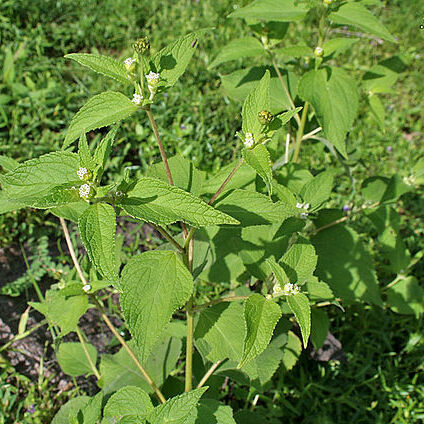Herbs, annual. Stems erect, 40-60 cm tall, branched. Lower leaves opposite, with up to 1 cm petioles, blade ovate to ovate-lanceolate, 3-6 × 2-3 cm, both surfaces scabrid, base cuneate, margin sparsely serrate, apex acuminate; upper leaves smaller, usually alternate, ovate to ovate-oblong, 2-3 × 1.3-1.5 cm, base usually rounded. Capitula axillary or terminal, ca. 1 cm in diam.; peduncles slender, 15-40 mm, with spreading hairs; phyllaries 2-seriate, outer papery, green, ovate-oblong, ca. 6 mm, dorsally densely hairy, apex shortly acute or obtuse, inner ovate to oblong-linear, ca. 5 mm, sparsely pubescent, apex acute; paleae oblong-lanceolate, ca. 5 mm, dorsally pubescent, apex aristiform. Ray florets 1-seriate, yellow or yellowish white, lamina ca. 3 mm, apex 2-4-toothed. Disk florets campanulate, limbs 5-toothed. Achenes densely pubescent, those in female florets 3-angled, ca. 4 mm, those in bisexual florets compressed, ca. 5 mm; pappus short, unequal, 2-5. Fl. Apr-Jun.
Annual herb, erect, 0.3–1.2 m high; stems hardly to much branched, scabrid-pilose.. Leaves elliptic to ovate, to 12 cm long, to 8 cm wide, base cuneate, margins serrate-crenate, apex acuminate, 3-veined from base, scabridulous.. Capitula slightly elongate-campanulate; involucre 10 mm long; phyllaries pale green with darker veins, oblong to elliptic, pilose and glandular.. Ray florets whitish, 3–5, ray 1–1.6 mm long, glabrous; disc florets whitish, 3.6 mm long.. Achenes narrowly obovoid, 3–5 mm long; pappus of 1–3 weak bristles to 1 mm long, on the edge of a shallow cup.. Fig. 154 (p. 736)

